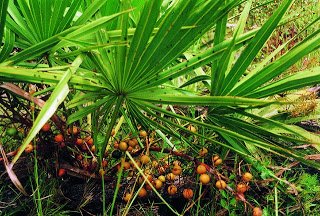Home
Muira Puama bark
Tribulus terrestris
Panax Ginseng
Wild Oats milky seed
Maca Root
Fo-Ti root
Saw Palmetto extract
Sarsaparilla root
Yohimbine
Horny goat weed
Saw Palmetto extract
Classification
Saw Palmetto berry extract is the extract of the fruit of Serenoa repens. It is the sole species currently classified in the genus Serenoa. Saw palmetto is a fan palm, with the leaves that have a bare petiole terminating in a rounded fan of about 20 leaflets. The petiole is armed with fine, sharp teeth or spines that give the species its common name. The teeth or spines are easily capable of breaking the skin, and protection should be worn when working around a Saw Palmetto. It is endemic to the southeastern United States, most commonly along the Atlantic and Gulf Coastal plains, but also as far inland as southern Arkansas. It is a hearty plant; extremely slow growing, and long lived, with some plants, especially in Florida where it is known as simply the palmetto, possibly being as old as 500–700 years.
Common names for this herb
Saw Palmetto extract
Saw Palmetto berry extract
Serenoa repens
Sabal serrulatum
American dwarf palm tree
Cabbage palm
Dwarf palm
Palmetto scrub
Fan Palm
Scrub Palm
Palmetto
Tala
Cani
Taalachoba
Talimushi
Guana
Chemical Composition
It is rich in fatty acids and phytosterols which thought to work on inhibition of both forms of 5-alpha-reductase with no reduction in cellular capacity to secrete prostate-specific antigen is indicated.
Other proposals for mechanisms of action include interfering with dihydrotestosterone binding to the androgen receptor, relaxing smooth muscle tissue similarly to alpha antagonist drugs, and acting as a phytoestrogen.
How saw palmetto extract works
The effect of saw palmetto extract on erectile dysfunction involve many mechanisms. It might be the fact that it helps with BPH and other urinary conditions that these people feel improvement in there performance after a certain period with this herb intake.
Saw palmetto is thought to inhibit the conversion of testosterone to dihydrotestosterone (DHT). DHT is a breakdown product of the hormone testosterone. It is a biologically active compound and has a role in stimulating and controlling the development and maintenance of masculine features and characteristics. DHT is three times more potent than testosterone and plays a role in the development of male pattern baldness and benign prostatic hypertrophy.
Numerous meta-analyses of clinical trials S. repens extract in the treatment of BPH have found it safe and effective for mild-to-moderate BPH compared to placebo, finasteride, and tamsulosin. An updated meta-analysis including these trials found that saw palmetto extract “was not more effective than placebo for treatment of hyperplasia but following two million U.S. who use saw palmetto, urinary problems are greatly reduced. However, saw palmetto extract was comparable to tamsulosin and finasteride in this meta-analysis. Longer-term (2 years; most clinical trials have been 1 year) open studies suggest that saw palmetto reduces the risk of men with BPH ultimately needing to have surgery.
These days it is commonly used for:
Chronic pelvic pain
Prostatitis
Bladder disorders
Decreased sex drive
Hormone imbalances
Daily allowance and dosage
For enlarged prostate (benign prostatic hypertrophy), most experts suggest 320 mg daily, in one dose or two divided doses. In some reports, patients have been given 160 mg once daily.
Traditional or other suggested doses that are less studied include: 1 to 2 g of ground, dried, or whole berries daily; 2 to 4 mL of tincture (1:4) three times daily; 1 to 2 mL fluid extract of berry pulp (1:1) three times daily; or tea (2 teaspoons dried berry with 24 oz water, simmered slowly until liquid is reduced by half) taken as 4 oz three times daily. Teas prepared from saw palmetto berries are potentially not as effective because the active ingredients may not dissolve in water. Some experts believe that a preparation called lipidosterolic extract of Serenoa repens (LSESR) may cause fewer side effects.
Safety and side effects
The most common are gastrointestinal, some of which may be reduced by taking the extract with food.
Use may increase the risk of bleeding or affect sex hormones, and concurrent use of other drugs with similar action should be avoided.
Beta-sitosterol, a chemical present in saw palmetto extract, is chemically similar to cholesterol. High levels of sitosterol concentrations in blood have correlated with increased severity of heart disease in men who previously suffered heart attacks.
As with other herbal preparations, precise chemical constituents may vary by manufacturer and batch. Contraindications include pregnancy, lactation due to antiandrogenic and estrogenic activity.

